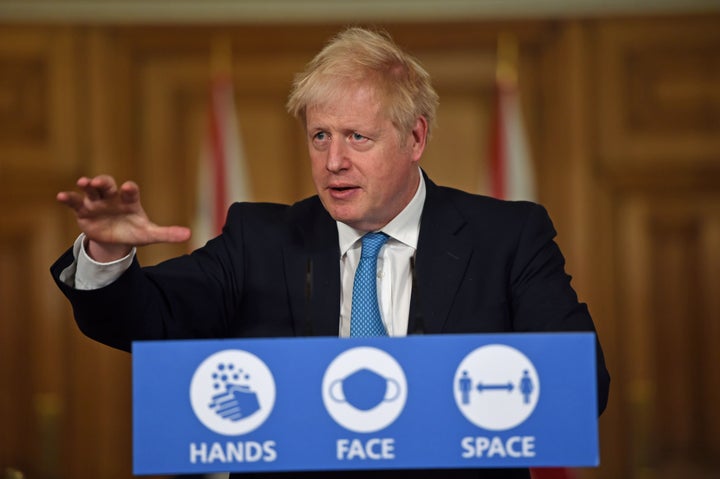
You’re reading The Waugh Zone, our daily politics briefing. Sign up now to get it by email in the evening.
“You want the moon? Just say the word, and I’ll throw a lasso around it and pull it down.” Boris Johnson is hardly George Bailey, the humble soul who gives up his dreams to help others in the classic Christmas movie “It’s A Wonderful Life”. But today he at least had some concrete plans to get his “moonshot” of super-fast tests that really could help in the fight against Covid.
All the headlines from the PM’s No.10 press conference will focus on his ongoing devolution ding-dong with Andy Burnham (Johnson effectively said he will go ahead with or without the Greater Manchester mayor) and his hardline on Brexit, yet it was the quiet announcement of new testing developments that felt much more interesting.
Johnson said that all “Very High Risk” areas would be prioritised for two types of rapid test, hugely improving the scale and speed at which people can be cleared or isolated. One will help test asymptomatic NHS staff on a regular basis (‘LAMP’ tests) and the other will help care homes, schools and universities (“lateral-flow tests”) to get results – without a lab and within 20 minutes.
Although these are tentative roll-outs and will supplement not replace current testing, the PM also said that “we have started building the infrastructure for domestic manufacture” to ensure numbers could go into the millions.
As it happens, I’m told bioscience firms that are members of BIVDA (the British In-Vitro Diagnostic Association) have indeed been asked by NHS Test and Trace to “repurpose” their manufacturing capabilities, amending processes for things like pregnancy tests to use their factories to produce the new Covid tests.
Two firms alone, BBI and Abingdon, will have a manufacturing capacity of upto seven million test a day, once issues like tech transfer are resolved and test sensitivity standards are passed.
But what was notable was the way Johnson today scaled back his ambition, admitting it will take time to build not just the capacity but the logistics capability to deliver large numbers across the country. Back in early September, his super-optimistic prediction was that “millions” of people could “behave in a way that was exactly as in the world before Covid”, going to the theatre or sports events once cleared by a rapid test.
Today, with the second wave a scary reality, he admitted “we won’t be able to use testing to get business back to normal quickly” and “I must level with you that it will take time to get this right before many organisations can buy and operate these tests themselves”. Still, if the rapid tests do help the routine testing of NHS staff, of care homes and schools and universities, they could prove hugely important.
It’s the performance of Johnson’s test-and-trace system and its current PCR lab tests that are of more immediate concern to many. Matt Hancock insisted this week that it was “on track” to meet the 500,000 daily testing capacity target by the end of this month, even though that capacity is currently around 350,000. With only a 5% week on week increase, just how will we get to the half million figure?
Well, I’m told that with just a fortnight to go to get a huge 150,000 increase, those within NHS Test and Trace are confident they will indeed hit the magic number on time. This is because the rise will not be linear but will come in big jumps, prompted by the expansion of whole extra floors and staff in current labs, both in private Lighthouse labs and NHS labs.
The beleaguered service is also bullish too about its ability to improve contact tracing, which this week fell back again. The drop was caused in part by the need to train up local tracers working with yet more councils as the system switches to a more local service, I’m told. More than 100 local teams are now operating, with 65 more in the pipeline. National call centre staff have nearly halved, while local tracers and the clinicians who back them up have increased markedly in recent weeks.
This shift to local expertise, long demanded by public health chiefs, is paying off. Figures are not yet published but I understand that 80% of the new locally-led teams are showing improved contact tracing. Places like Blackburn which pioneered it, have been very effective in getting to hard-to-reach communities through local knowledge, and boosting self-isolation numbers by sorting out food deliveries, wage support and childcare help.
As for that 500,000 target set by the PM, if it is reached at the end of this month, it will not be all used by any means. The whole point is to use the expanded capacity to improve turnaround times and not necessarily to radically increase numbers of tests done daily. The aim is to ensure the system is not “running hot” and has some slack to help swift processing.
Of course, as Sir Patrick Vallance reminded us today, “testing only works if people isolate”. If isolation numbers don’t improve (and they are difficult to accurately estimate) the need for perhaps even greater financial support may become unavoidable. But perhaps the biggest driver in improving England’s ability to contain the spread could end up being one simple thing: fear. Some in government think rising hospitalisations, and deaths, may be the only real spur to getting the public to treat the virus seriously again.
